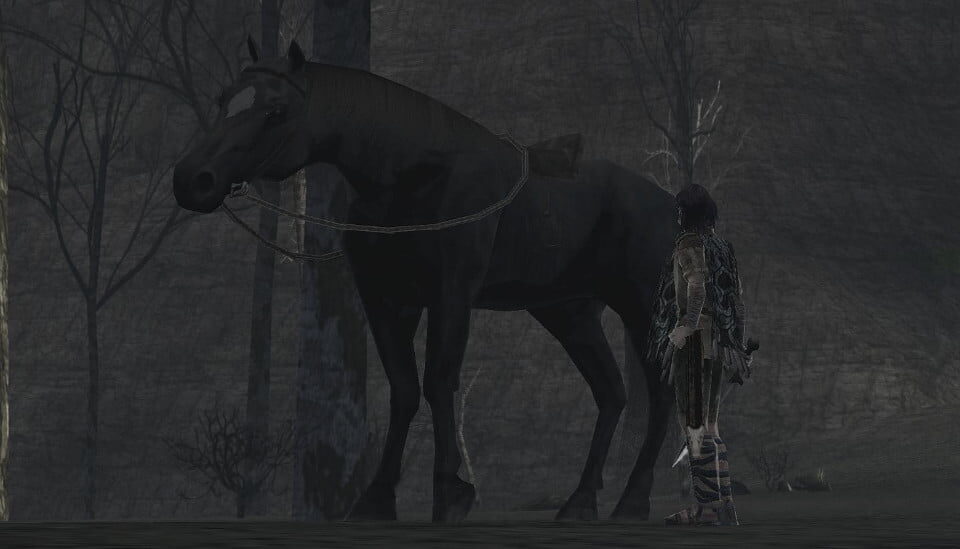Shadow of the Colossus grasps how slowness and inaction can give rise to contemplation, perfectly underscoring the quietude of solitary travel and hardship.
Shadow of the Colossus, the second release from developer Fumito Ueda and Team Ico’s arcane triptych situated between Ico and The Last Guardian, grasps how slowness and inaction can give rise to contemplation and mournfulness. Their game underscores the quietude of solitary travel and hardship, redefining the archetypical “save the princess” narrative as something considerably more forlorn and lonesome even as it expands the parameters of what video games can make us feel. For a medium defined by interactivity, the act of decelerating and stripping down gameplay would seem antithetical to the assets of video games. However, Shadow of the Colossus deploys slowness and decreased action to reconsider how we experience duration in games. Long stretches of wordless, minimal gameplay as the protagonist simply travels from one point to another implicitly prompt the player to engage in self-reflection. With nothing else to do besides move forward through empty spaces, the game privileges solitude, pinpointing the relationship between man, nature, and time.
The game is essentially composed of two halves: traveling to the sixteen titular colossi on horseback, and engaging them in combat. What I’m interested in aren’t the battles but the time it takes to simply reach the colossi. The travel segments in Shadow of the Colossus suggest a counter-aesthetic to video games, coercing players to feel the passage of time and to soak in empty spaces rather than travelling quickly and carelessly. The game does not overload the landscape with teeming side quests, secondary objectives, or a litter of collectible items but is instead indicative of a fundamental cleansing of open-world conventions. While many video games tend to be saturated with junk content to augment its “replay value” or to give “value for money” Shadow of the Colossus avoids polluting its world with such detritus. Instead, it values simplicity and lulls in action; not overcrowded objectives and distractions but openness.
A number of hollow open-world games like the recent Far Cry entries or the unfortunately lacklustre Mirror’s Edge Catalyst are filled with things for the player to consume and colonise, offering little room to pause for reflection. The strength of Shadow of the Colossus lies in its privileging of unadorned, solitary travel, emphasising how this simple act is worthy of our time. By centralising the act of movement from one point to the other, it anticipates walker games that deemphasise gameplay in favour of minimalism and duration like Journey or Dear Esther. These games allow the player to freely roam from one point to another, and along the way steep us in a hushed, solemn atmosphere devoid of character interactions so that we may enter a contemplative mode of play. Of course, these “walker” games – often referred to as “walking simulators” – are exceptions to the norm because most games and gamers don’t value slowness and inactivity. When traditional conventions of gameplay like combat or puzzles are removed in favour of simple movements, most audiences are averse to such design choices. Why is this?
Walker games and the travel sections of Shadow of the Colossus negate entrenched understandings of video game action. Most games are about shooting or overcoming anonymous enemies, and of moving from one set piece to the next. Rarely do games offer the opportunity to reflect and to be self-critical of what transpires, but instead keeps players constantly locked in action. Although many video games equate inactivity as not making use of games’ interactive quality, stripping away that interactivity can be used as a conscious artistic choice. It highlights the few actions we can do, and we become hyper-aware of ourselves in relation to the game environment. A few like-minded games like the Silent Hills teaser P.T. gesture towards the artistry that comes with minimising gameplay: less can be significant, even frighteningly so. Still, the prevailing trends expectedly gravitate towards more action-oriented and bombastic titles. Look no further than how Battlefield 1 reduces the complications of World War I to a fun shooter game in service of explosive action and excitement without considering the solemnity and nuances of historical change beyond violence. Swept away is the sense that the First World War represents a multifaceted conflict where old European values of honour and glory were slaughtered in a meaningless no man’s land, where La Belle Époque (The Beautiful Era) gave way to the Lost Generation, and where governments fell to later fascist regimes. Such games like Battlefield 1 are too loud and hurried to consider the possibility of slowness and self-critique.
Indeed, most games even have “fast-travel” options that permit players to jump across spaces, rendering games elliptical and cutting out the “boring” parts of travel. Shadow of the Colossus relishes extended duration and lets us feel the heavy burden of travel, and by extension, the heaviness that the protagonist Wander feels. By coercing players to unhurriedly traverse the landscape instead of cutting directly to action, players can indulge in leisurely woolgathering because our minds meander when faced with the monotonic uniformity of the landscape. Long stretches of the game are spent on empty, de-saturated plains, lending Shadow of the Colossus a painterly quality. The static image of an isolated horse and rider dwarfed by towering cliffs evokes the expressiveness of a landscape painting, and the languid travels allow players to probe a clear, drifting headspace.
The clarity of mind permitted by measured travel obliges players to consider the mysterious storyline and setting of the game as well. Shadow of the Colossus begins in medias res with Wander accompanied by his horse Argo and the dead princess Mono as they arrive at the soulless Forbidden Land and its central Shrine of Worship. The game provides little to no backstory and characterisation, instead throwing players right into the central conflict of killing sixteen peaceful colossi in exchange for Mono’s resurrection. The circuitous storyline of the game – traveling outward from the Shrine to the colossi and mysteriously returning after one has been slain – accentuates a cryptic sense of ominousness. Sections of wordless gameplay shroud the protagonist with suspicion, and Wander’s intentions and motivations are often unclear. Since the land is labeled “Forbidden,” Wander is trespassing on hallowed ground, and upon reflection, it’s clear to see that his endeavour is selfish and destructive. This underlying wickedness contrasts the romanticised hinterlands of the Forbidden Land, a place outside of time like Shangri-La or Arcadia. Mysterious landscapes like craggy beaches, imposing canyons, crumbling redoubts, and earthy moors of moss and peat are home to the game’s quixotic knight, roaming giants, and its central slumbering princess. At its heart, Shadow of the Colossus occupies the realm of the fairytale.
The spectacular imagery of the fairytale certainly comes across in the game’s eponymous colossi and epic scale of its landscapes, and its principal act of slow, purposeful travel also warrants scrutiny as a form of fantastic spectacle. It takes roughly eight minutes to cross the ancient stone bridge that links the outside world with the Forbidden Land, easily besting the measly two minutes to climb the lauded ladder sequence in Metal Gear Solid 3: Snake Eater. The ability to cross this bridge and the lack of fast-travel allows players to feel the sheer scale of the game’s natural landscapes and to marinate in its atmosphere and somber tone, reflecting Wander’s own herculean task. It also evokes a history of glacially-paced art films shot in single takes, including Andrei Tarkovsky’s Nostalghia and its nine-minute single take or the works of the late Abbas Kiarostami and his interest in locating a sense of the poetic in slow-moving, open images. The former example is especially pertinent to Shadow of the Colossus. The nine-minute take in Nostalghia involves the protagonist oscillating back and forth across a drained pool with a lit candle, an action that is ultimately self-destructive in an effort to save others. Likewise, Wander journeys for lengthy stretches of time but eventually destroys himself in the process, and sections of unabridged duration underscore his steady deterioration.
The slow pacing and hushed travelling in Shadow of the Colossus emphasises contemplation but also decay, specifically the slow march of death for Wander throughout his excursions. An astute retrospective on the game by Gareth Damian Martin for Kill Screen recognises how somber the game feels and how Shadow of the Colossus is ultimately concerned with death even though there are no dead bodies strewn around or bloodshed. Instead, the funereal pall that hangs heavily over the proceedings and the leftover ruins and ghostly emptiness of the environment render the entire landscape “a tomb.” Wander is the only human being present for much of the game, and his solitary rides through open fields are devoid of narration or dialogue. Thus, we must fill in the words where there are none in order to better understand the game: Who is this character? What is this place’s history, its mythology, its religion? What are the consequences of killing these colossi?
For all its interest in duration and slow travel, Shadow of the Colossus does offer a form of fast-travel that often goes unremarked. We can only ever travel towards the colossi, and the game denies us the ride back to the Shrine of Worship, instead presenting us with an elliptical fade to black after Wander defeats a colossus and slips unconscious. Thus, we always travel towards violence and never ride back to safety; we cannot consciously retreat back to the spiritual place of the Shrine. Shadow of the Colossus denies us the restful state of falling action once we defeat a colossus because a new one immediately takes its place, and the only time to reflect is in the ride towards a new enemy. Contrast this narrative structure with a game like Hotline Miami, which forces the player to retread on violent ground scattered with the bloodied corpses of those killed, thus illuminating one’s savage bloodlust with a sobering journey backwards. Conversely, Shadow of the Colossus is all forward movement, keeping its violence hidden. We rarely (if ever) see the defeated colossi, and the consequences of our actions are out of sight unless players deviate from the main objective and return to previous sites. What remains of the vanquished colossi are grown over with vegetation and seemingly returned to the landscape, thus raising pressing questions of how much time actually elapses in the game. There are questions like this that the game lets sit quietly, left unanswered as we kill one colossus after another. It lingers in the mind as Wander travels silently and alone.
Video games seldom appreciate the value of slowness and quietude for extended durations, much less for the majority of gameplay, but this artistic choice can upend expectations of the art form by offering new means of interacting with its world. The closest analogue to Shadow of the Colossus is perhaps the under-appreciated browser game The Killer by Jordan Magnuson for his compelling “Game Trekking” series, so-called “notgames” for their disinterest in flashy action or complex gameplay. Like Shadow of the Colossus, The Killer is about travelling to some faraway destination for the pretext of killing another living thing. The time it takes to reach that destination is similarly prolonged, granting players the space for contemplation to wonder why such acts of violence are being carried out in the first place. Likewise, Magnuson depicts characters mired in violence and cut off from the lush beauty of nature that surrounds them (soaring mountains, a shimmering canopy of stars, a field of flowers). Both games seek meaning inwardly, rendered in patient fluctuations of time, unhurried movements, and minimal language. This decelerated, contemplative mode of gameplay offers the kind of forthright self-reflection that exists on the periphery of contemporary mainstream gaming, granting these rare works an earthbound pensiveness that more hurried games breeze by altogether.
All of the images in this article were created by Electric Blue Skies, who graciously allow their images to be used for free with proper attribution. High quality, artistic screenshots take a lot of time and effort to produce. Please keep that in mind if you want to link or use anything found here.
This article was originally published on 25th July 2016.









